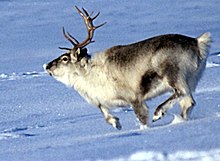Reindeer
| Reindeer | |
|---|---|
 | |
| Conservation status | |
| Scientific classification | |
| Kingdom: | Animalia |
| Phylum: | Chordata |
| Class: | Mammalia |
| Order: | Artiodactyla |
| Family: | Cervidae |
| Subfamily: | Capreolinae |
| Genus: | Rangifer C.H. Smith, 1827 |
| Species: | R. tarandus |
| Binomial name | |
| Rangifer tarandus (Linnaeus, 1758) | |
| Subspecies | |
many, see text
| |
 | |
| Reindeer habitat divided into North American andEurasian parts | |

The reindeer (Rangifer tarandus), also known as the caribou in North America, is a species of deer native to Arctic and Subarctic regions. This includes both resident and migratory populations. While overall widespread and numerous,[1] some of its subspecies are rare and at least one has already goneextinct.
Reindeer vary considerably in color and size. Both sexes grow antlers, though they are typically larger in males. However, there are a few populations in which females lack antlers completely.
Wild reindeer hunting and herding of semi-domesticated reindeer (for meat, hides, antlers, milk and transportation) are important to several Arctic and Subarctic peoples. Even far outside its range, the reindeer is well known due to the myth, probably originating in early 19th century America, in whichSanta Claus's sleigh is pulled by flying reindeer, a popular element of Christmas.In Lapland, reindeer pull pulks.
Size
The females usually measure 162–205 cm (64–81 in) in length and weigh 80–120 kg (180–260 lb)[15] The males (or "bulls") are typically larger (although the extent to which varies in the different subspecies), measuring 180–214 cm (71–84 in) in length and usually weighing 159–182 kg (350–400 lb),[15] though exceptionally large males have weighed as much as 318 kg (700 lb).[15] Shoulder height typically measure from 85 to 150 cm (33 to 59 in), and the tail is 14 to 20 cm (5.5 to 7.9 in) long. The subspecies R. t. platyrhynchus from Svalbard island is very small compared to other subspecies (a phenomenon known as insular dwarfism), with females having a length of approximately 150 cm (59 in), and a weight around 53 kg (120 lb) in the spring and 70 kg (150 lb) in the autumn.[16] Males are approximately 160 cm (63 in) long, and weigh around 65 kg (140 lb) in the spring and 90 kg (200 lb) in the autumn.[16] The reindeer from Svalbard are also relatively short-legged and may have a shoulder height of as little as 80 cm (31 in),[16] thereby following Allen's rule.
Domesticated reindeer are shorter-legged and heavier than their wild counterparts.[citation needed]
[edit]Fur
The colour of the fur varies considerably, both individually, and depending on season and subspecies. Northern populations, which usually are relatively small, are whiter, while southern populations, which typically are relatively large, are darker. This can be seen well in North America, where the northernmost subspecies, thePeary caribou, is the whitest and smallest subspecies of the continent, while the southernmost subspecies, the Woodland Caribou, is the darkest and largest.[17] The coat has two layers of fur: a dense woollyundercoat and longer-haired overcoat consisting of hollow, air-filled hairs.


ไม่มีความคิดเห็น:
แสดงความคิดเห็น